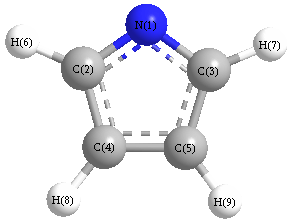Vibrational Frequencies calculated at CISD/6-311G*
| Mode Number |
Symmetry |
Frequency
(cm-1) |
Scaled Frequency
(cm-1) |
IR Intensities
(km mol-1) |
Raman Act
(Å4/u) |
Dep P |
Dep U |
|---|
| 1 |
A1 |
3357 |
3107 |
1.97 |
|
|
|
| 2 |
A1 |
3321 |
3073 |
2.09 |
|
|
|
| 3 |
A1 |
1649 |
1526 |
1.61 |
|
|
|
| 4 |
A1 |
1533 |
1419 |
27.93 |
|
|
|
| 5 |
A1 |
1266 |
1172 |
3.91 |
|
|
|
| 6 |
A1 |
1146 |
1060 |
38.83 |
|
|
|
| 7 |
A1 |
1088 |
1007 |
0.28 |
|
|
|
| 8 |
A1 |
919 |
850 |
11.83 |
|
|
|
| 9 |
A2 |
931 |
862 |
0.00 |
|
|
|
| 10 |
A2 |
871 |
806 |
0.00 |
|
|
|
| 11 |
A2 |
526 |
486 |
0.00 |
|
|
|
| 12 |
B1 |
872 |
807 |
0.52 |
|
|
|
| 13 |
B1 |
750 |
694 |
81.18 |
|
|
|
| 14 |
B1 |
577 |
534 |
23.47 |
|
|
|
| 15 |
B2 |
3546 |
3281 |
14122.46 |
|
|
|
| 16 |
B2 |
3321 |
3073 |
101.30 |
|
|
|
| 17 |
B2 |
3273 |
3029 |
3479.97 |
|
|
|
| 18 |
B2 |
1377 |
1274 |
84.20 |
|
|
|
| 19 |
B2 |
1335 |
1235 |
59.85 |
|
|
|
| 20 |
B2 |
1064 |
984 |
0.23 |
|
|
|
| 21 |
B2 |
916 |
848 |
1.07 |
|
|
|
Unscaled Zero Point Vibrational Energy (zpe) 16819.9 cm
-1
Scaled (by 0.9253) Zero Point Vibrational Energy (zpe) 15563.4 cm
-1
See section
III.C.1 List or set vibrational scaling factors
to change the scale factors used here.
See section
III.C.2
Calculate a vibrational scaling factor for a given set of molecules
to determine the least squares best scaling factor.
